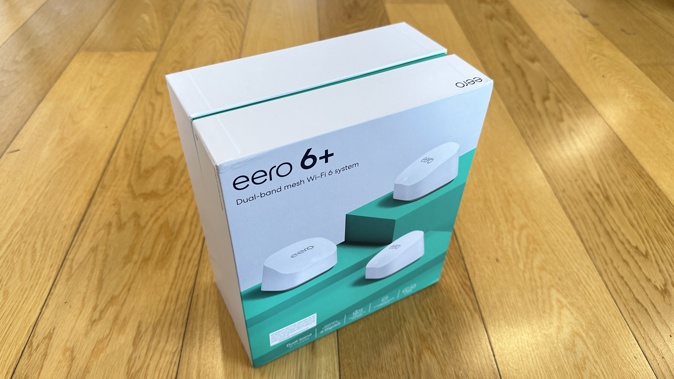
Before you continue reading I feel obliged to remind you I'm not an expert. In anything.
The only reason I get to play with these marvellous toys and write these reviews is because I said, "Yes!" when somebody asked me to.
I don't have any certifications in electrical engineering. I don't understand much of the physics involved in making most of these modern gadgets work.
My only qualification is I've been doing this for a long time. I've reviewed a lot of smartphones and even more earbuds, not to mention speakers, computers, cars and lawnmowers.
And I've certainly set up more than my share of home Wi-Fi networks.
So it's fair to say I've picked up a few solid impressions along the way. But just when I thought I had a clear idea of which routers, extenders and mesh systems are likely to work better than others, I received a very interesting box from Amazon.
The eero 6+ system is Amazon's latest dual-band mesh Wi-Fi system; you can buy the units individually or in a three-pack, like the one I've been trialling. While the box they come in is fairly large, the eero+ units themselves are positively tiny - definitely the smallest home networking devices I've ever used.
Recently I've come to the conclusion bigger is definitely better when you're dealing with Wi-Fi routers and extenders. I've found more power, more bands and more antennae are the only foolproof solution to blanketing the whole house with fast, full-on, reliable coverage. So when I saw how small the eero 6+ routers were, I didn't have high expectations.
On the upside, being so mini, they're super easy to hide away and to be honest, even when they're sitting on a shelf in plain view, you don't really notice them as other than the eero logo across the top, they don't have any other distinguishing features. Even the USB-C power adapters are small and nestle in easily beside other plugs on a multiboard.
Setup is a complete doddle - especially if you already have an Amazon account. The eero app (obviously there's an app) guides you through each step of the process and I created my new home network in no time at all. Unlike some mesh systems, each of the three eero 6+ units is identical - any one can be used as the primary router.
There are only two 1GB ethernet ports on the back of each device, so this might be a limiting factor if you were planning hardwiring a lot of gear into any of them - although interestingly they're described as "auto-sensing" ports so it doesn't seem to matter which you use for input or output.
Once set up, using the app you can deactivate the status LEDs on any of the three units, (yay!) update their firmware, test your connection speed and see exactly how many devices are connected to your network - and in most cases exactly what those devices are. This is very useful as you can then create different profiles and assign those devices accordingly. Interestingly, the eero app also monitors how much data each device is using and you can easily access that information if you're wondering where all your allowance is disappearing to.
And amazingly, it might be disappearing faster than you think. Because the big surprise for me was how effectively these three little routers provided my whole house with very fast connectivity - and not just fast but faultlessly stable too.
The main reason this was so unexpected is the eero 6+ setup is only a dual-band system - so there's no dedicated line for backhaul - this is how the modules communicate with each other. Tri-band and quad-band systems use dedicated backhaul to keep the rest of your Wi-Fi space free for your devices, preventing a clogged-up, slowed-down system.
And yet, all my devices functioned perfectly - many of them better than ever - especially IoT gadgets like my smart speakers, video doorbell and security cameras - not to mention my smart lights. I can't fully explain this, although Amazon claims the eero 6+ system can work as a smart home hub thanks to its built-in Thread and Zigbee capabilities. These are non-Wi-Fi wireless protocols that mean connected smart devices like lights, switches and sensors can carry on doing their thing without hogging any of your internet bandwidth.
The Matter protocol has also just fired up globally, the most brand-agnostic wireless technology yet. It's my understanding all the recent devices in the eero range are Matter enabled and as such will become an even more integral part of your home's IoT network once activated in future firmware updates (if they haven't been already).
I know all that sounds very airy-fairy and nerdy. My point is, I can't believe how good the connectivity of this network is. Just the fact it's Wi-Fi 6 means you're far more likely to achieve faster speeds with less congestion - adding in all those other smart home protocols also seems to keep things running super smooth and clear.
My intention with the eero 6+ system was to set it up, use it for the duration of this review, then put it back in the box again. But the truth is, it's working so well, I've left it up and running. The expression, "If it ain't broke, don't fix it," was never more appropriate. If I've learned one thing from my years of reviewing devices like these, if you find one that works, DO NOT MESS WITH IT.
Not only does the eero 6+ work, it works blazingly well and now there's no way I'm unplugging it.
Click here for more information and pricing on the Amazon eero 6+ dual-band mesh Wi-Fi 6 system.
Take your Radio, Podcasts and Music with you













